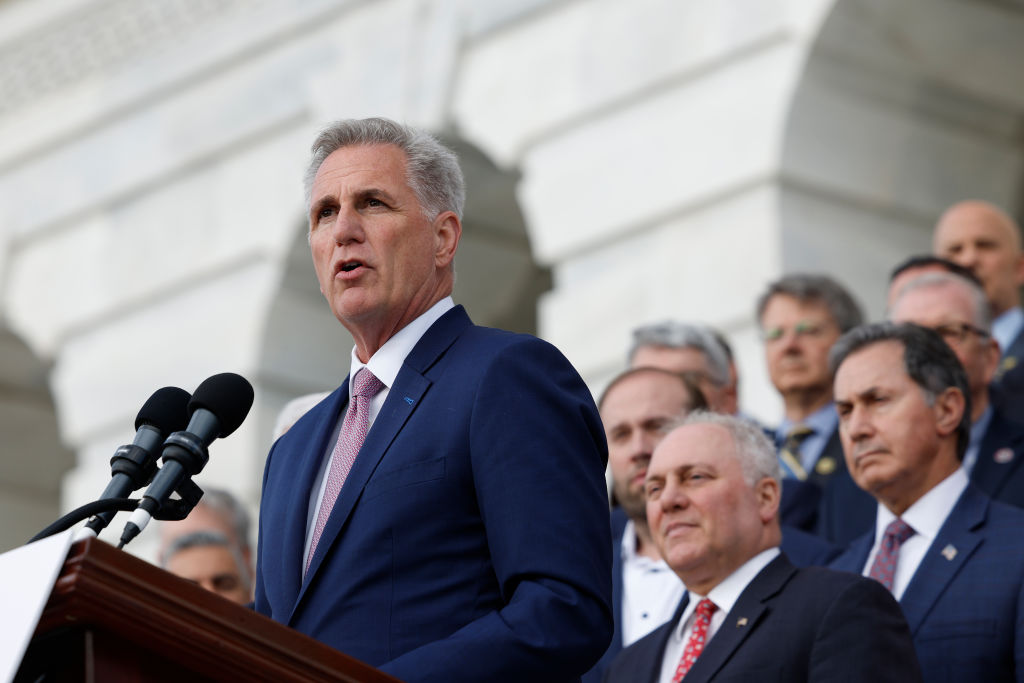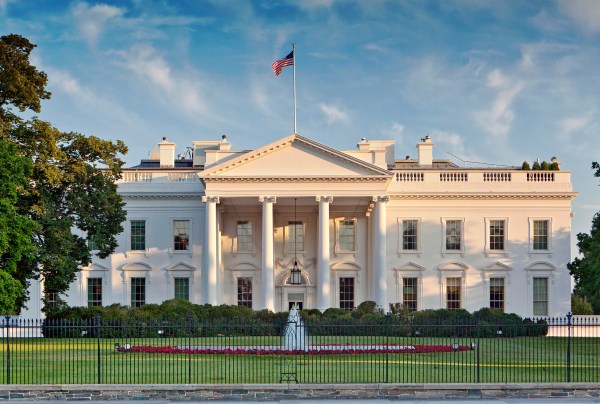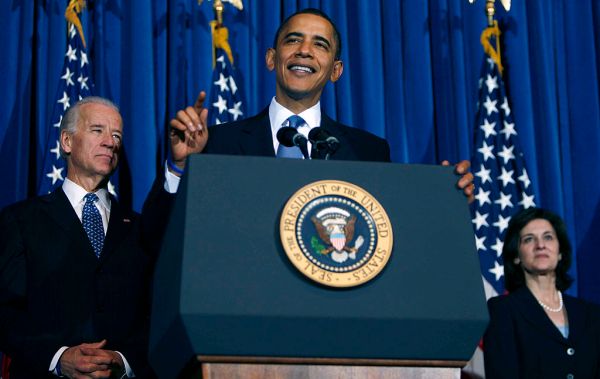There is perhaps no stranger American political tradition than the recurrent debt ceiling crisis, wherein Congress puts the country on the brink of financial disaster in the name of fiscal responsibility. As House Speaker Kevin McCarthy plans to introduce a bill to raise the debt ceiling and cut federal spending—setting up a potential showdown with President Biden—a look at the debt ceiling’s history can help us understand how we got here.
What is the debt ceiling?
Almost every year, the government spends more money than it collects in taxes. To make up the difference, the Treasury borrows money, which adds to the government’s debt. The debt ceiling is a congressionally imposed dollar limit on that debt.
If the goal of the debt ceiling is to keep the country’s debt down, it has not been remarkably effective. Congress first imposed a debt limit of $13.5 billion in 1917. Since then, U.S. government debt, adjusted for inflation, has grown more than a hundredfold. The debt ceiling’s apparent ineffectiveness helps explain why no other major country, with the not-so-notable exception of Denmark (their debt ceiling is a mere legal formality), has adopted the measure.
The debt ceiling does not actually restrict future spending—just the Treasury’s ability to pay for past expenditures. Congress can always approve new spending regardless of how close the national debt is to the ceiling, but the Treasury will be unable to pay those future bills (or any others) if doing so would cause the government’s debt to surpass its set maximum.
This has created a rather strange procedure. Congress first votes for spending. Then, months or years later, its members decide if they are going to raise the debt ceiling to let the Treasury pay for that spending—essentially voting whether to pay their bills. Unsurprisingly, Congress always votes to raise the debt ceiling, though often not without significant commotion.
As a result of such commotion, Congress has not always raised the debt ceiling in a timely manner. In the spring of 1979, following extended congressional haggling on whether to raise the ceiling and some “technical errors” to boot, the Treasury failed to pay the government’s creditors on time. This default wasn’t cheap, costing the U.S. roughly $40 billion in today’s dollars because of increased interest rates. (The Treasury insists the 1979 fiasco wasn’t really a default, but experts, and the dictionary, disagree.)
Why have a debt ceiling?7
It turns out the debt ceiling was introduced not to keep the country’s debt down, but to more easily increase it. Before the ceiling was implemented during World War I, the Treasury needed congressional approval for every addition to the country’s debt. To fund the nation’s wartime efforts, Congress passed the Second Liberty Bond Act (named after the “Liberty Bonds” used to fund the war), creating a cap below which the Treasury could borrow without congressional approval.
The Treasury continued to enjoy this borrowing latitude until 1974, with the passage of the Congressional Budget and Impoundment Control Act. Congress reassumed control over the country’s borrowing, allowing itself to determine exactly what borrowing would be approved in its comprehensive annual budget—the practice that persists to the present day. However, Congress perplexingly decided not to remove the now-superfluous debt ceiling. Why must Congress keep a cap on Treasury borrowing when that borrowing already needs congressional approval?
That’s the question Richard Gephardt, an up-and-coming Democratic congressman from Missouri, asked himself in the fall of 1979. Months after that year’s Treasury default, the debt ceiling needed to be raised again, and he was put in charge of wrangling his party members’ votes. The job proved difficult—no self-respecting politician wants their name associated with an increase in the country’s debt—so Gephardt took a different approach. After reviewing the parliamentary rules, he proposed—and quickly passed—a bill that would automatically raise the debt ceiling to accommodate any new spending approved by Congress. With the exception of a minor crisis in 1985, the “Gephardt Rule” largely solved our debt ceiling problems … until, in the name of financial responsibility, it was suspended in 1995.
Within months of the rule’s suspension, the government shut down. After a dispute between President Bill Clinton and Speaker Newt Gingrich about raising the debt ceiling led to quarreling over the president’s spending, the government failed to pass a congressional budget. Still, proponents of its suspension and eventual repeal in 2001 stated that requiring a separate vote to raise the debt ceiling helps “restore accountability.” Modern supporters of a separate vote add that it incentivizes compromise and disincentivizes reckless spending. Whether or not that is true, a separate vote to raise the debt ceiling has undoubtedly provided ample opportunity for some good ol’ political brinkmanship.
A long tradition of brinkmanship.
The country’s many debt ceiling disputes have often been likened to games of chicken. Because Democrats and Republicans frequently need the other’s votes to raise (or suspend) the debt ceiling in time to pay the government’s bills, each party can attempt to extract concessions from the other in exchange for their cooperation, all while the government speeds toward financial disaster.
In 2011, Republicans withheld support for a debt ceiling increase in an effort to extract spending cuts from President Barack Obama. Obama blinked, cutting nearly $1 trillion in spending and promising to cut an additional $1.5 trillion by the end of the year in a deal to raise the debt ceiling at the eleventh hour. The kerfuffle rattled global markets and led to an unprecedented downgrade in the U.S. government’s credit rating by Standard & Poor’s. Still, Senate Minority Leader Mitch McConnell said at the time that the debt ceiling was “a hostage … worth ransoming. And it focuses the Congress on something that must be done.”
Such brinkmanship works only if the other party believes that you will not cave at the last moment. Hence, it is often beneficial to appear oblivious to the impacts of a crash or even seem to desire it. In 2011, for example, several Republicans appeared unaware of the consequences of failing to raise the debt ceiling—some wrongly suggested the government could “provide full faith and credit” without an increase, while others posited that failing to pay the nation’s debts would be no worse than furloughing some workers, closing down a few parks, or “not [cutting] the grass on the Mall.” Still others seemed to be in favor of financial disaster, with Sen. Jim DeMint stating, “I think we should do everything we can to avoid raising the debt ceiling.” By 2013, President Obama (who once voted against raising the debt ceiling as a senator) refused to engage in any negotiations to raise the debt ceiling—resulting in yet another debt ceiling crisis.
Now, we again seem to be playing a game of chicken, with Republicans demanding spending cuts and President Joe Biden emulating Obama’s tactics from a decade ago. We may escape unscathed this time, but if we play long enough—make a tradition out of it—someone will eventually swerve too late and we will head, full-throttle, into a financial crash.








Please note that we at The Dispatch hold ourselves, our work, and our commenters to a higher standard than other places on the internet. We welcome comments that foster genuine debate or discussion—including comments critical of us or our work—but responses that include ad hominem attacks on fellow Dispatch members or are intended to stoke fear and anger may be moderated.